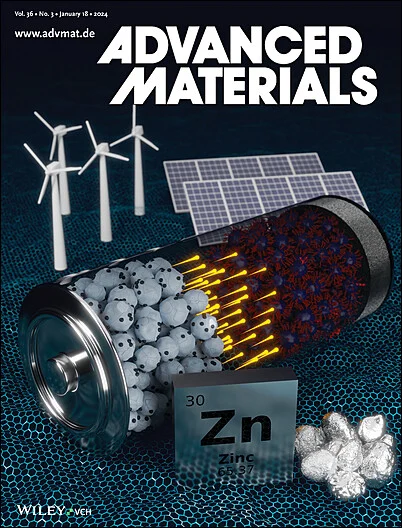磺胺优选平行排列实现高性能倒钙钛矿太阳能电池。
IF 26.8
1区 材料科学
Q1 CHEMISTRY, MULTIDISCIPLINARY
引用次数: 0
摘要
分子添加剂由于具有抑制钙钛矿固有缺陷的潜力,成为提高钙钛矿太阳能电池(PSCs)性能和稳定性的一种非常有效的策略。然而,添加剂的原子构型和电子性质对其钝化性能的影响却很少受到关注。本文研究了两种苯磺酸酰胺衍生物,4-羧基苯磺酸酰胺(CO-BSA)和4-三苯基苯磺酸酰胺(CN-BSA),研究了具有不同电子受体官能团的分子对钙钛矿层缺陷钝化和钙钛矿太阳能电池(PSCs)光伏性能的影响。发现CN - BSA和CO - BSA在钙钛矿内优先采用平行排列的结合取向,从而与相邻的两个欠配位的Pb2+缺陷位点形成强配位。同时,CO - BSA表现出比CN - BSA更有利的电子构型,使官能团具有更高的电子密度,从而能够与非配位Pb2+缺陷进行更强的双位点结合。此外,CO-BSA的加入促进了大晶粒尺寸、高质量和低缺陷密度的钙钛矿薄膜的形成。因此,用CO-BSA修饰的器件的效率为26.53%(认证为26.31%)。在空气中进行1100小时的稳态功率输出(SPO)测量后,封装的co - bsa基电池仍保持96.1%的初始效率。本文章由计算机程序翻译,如有差异,请以英文原文为准。
Preferred Parallel Alignment of Sulfonamide Enables High-performance Inverted Perovskite Solar Cells.
Molecule additives emerge as a highly effective strategy for enhancing the performance and stability of perovskite solar cells (PSCs), owing to their potential in suppressing intrinsic defects in perovskite. However, the influence of atomic configuration and electronic properties of additives on their passivation performance receives little attention. Here, two benzenesulfonamide derivatives, 4-carboxybenzenesulfonamide (CO-BSA) and 4-cyanobenzenesulfonamide (CN-BSA) are investigated, examining the effects of molecules with different electron‑acceptor functional groups on the defect passivation of perovskite layer and the photovoltaic properties of perovskite solar cells (PSCs. It is found that CN‑BSA and CO‑BSA preferentially adopt parallel-aligned binding orientations within the perovskite, enabling strong coordination to two neighboring undercoordinated Pb2+ defect sites. Meanwhile, CO‑BSA exhibits a more favorable electronic configuration than CN‑BSA, which endows the functional groups with a higher electron density that enables stronger dual-site binding with uncoordinated Pb2+ defects. Moreover, incorporating CO-BSA promotes the formation of perovskite films with large grain sizes, high quality, and low defect densities. Consequently, the device modified with CO-BSA achieves an efficiency of 26.53% (certified 26.31%). The encapsulated CO-BSA-based cell retains 96.1% of its initial efficiency after 1100 h of steady-state power output (SPO) measurement in air.
求助全文
通过发布文献求助,成功后即可免费获取论文全文。
去求助
来源期刊

Advanced Materials
工程技术-材料科学:综合
CiteScore
43.00
自引率
4.10%
发文量
2182
审稿时长
2 months
期刊介绍:
Advanced Materials, one of the world's most prestigious journals and the foundation of the Advanced portfolio, is the home of choice for best-in-class materials science for more than 30 years. Following this fast-growing and interdisciplinary field, we are considering and publishing the most important discoveries on any and all materials from materials scientists, chemists, physicists, engineers as well as health and life scientists and bringing you the latest results and trends in modern materials-related research every week.
 求助内容:
求助内容: 应助结果提醒方式:
应助结果提醒方式:


